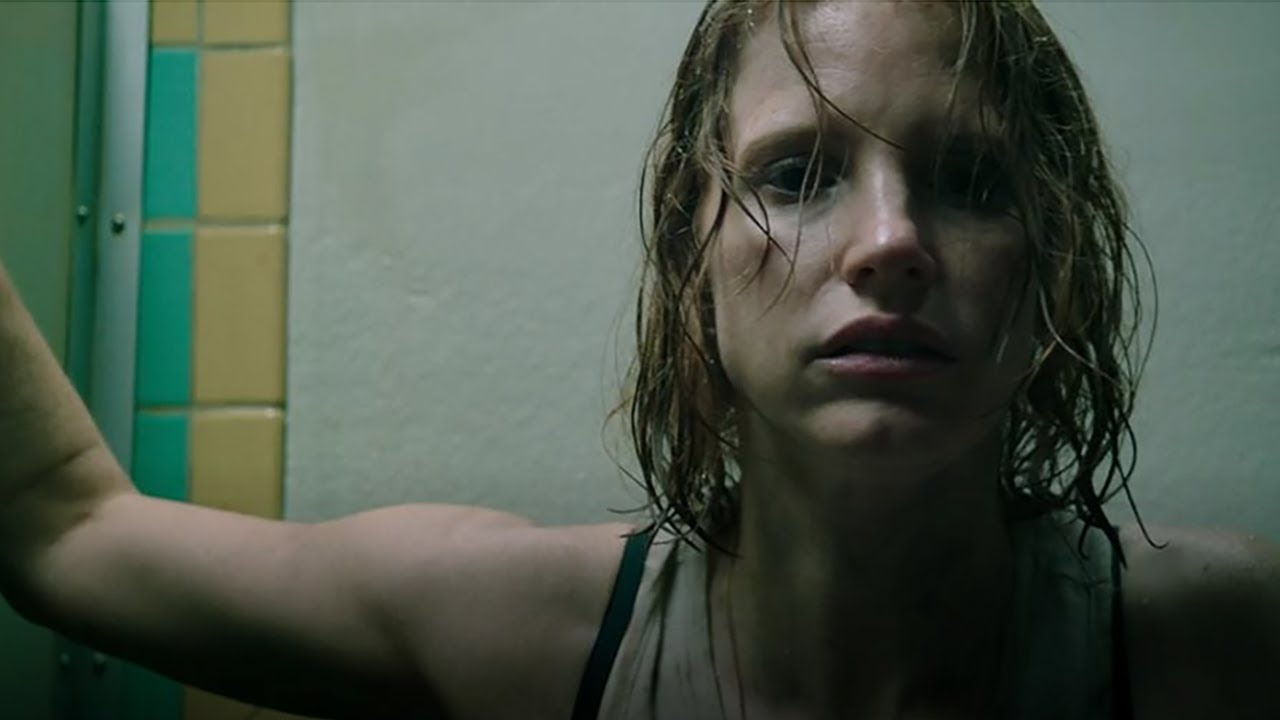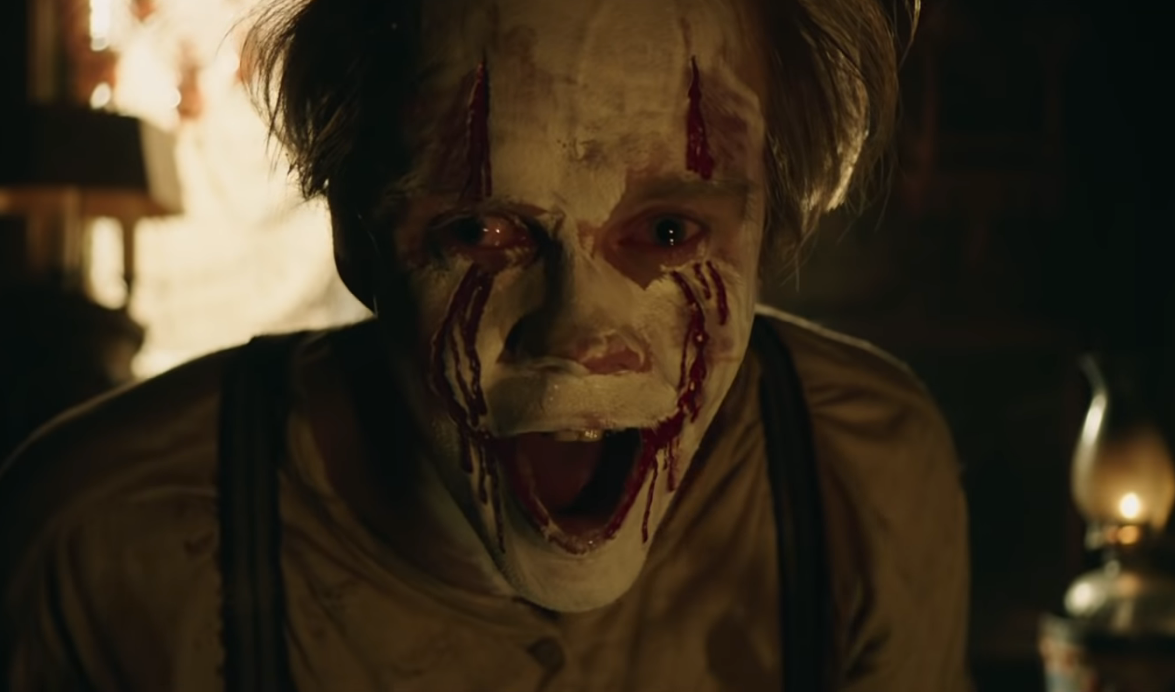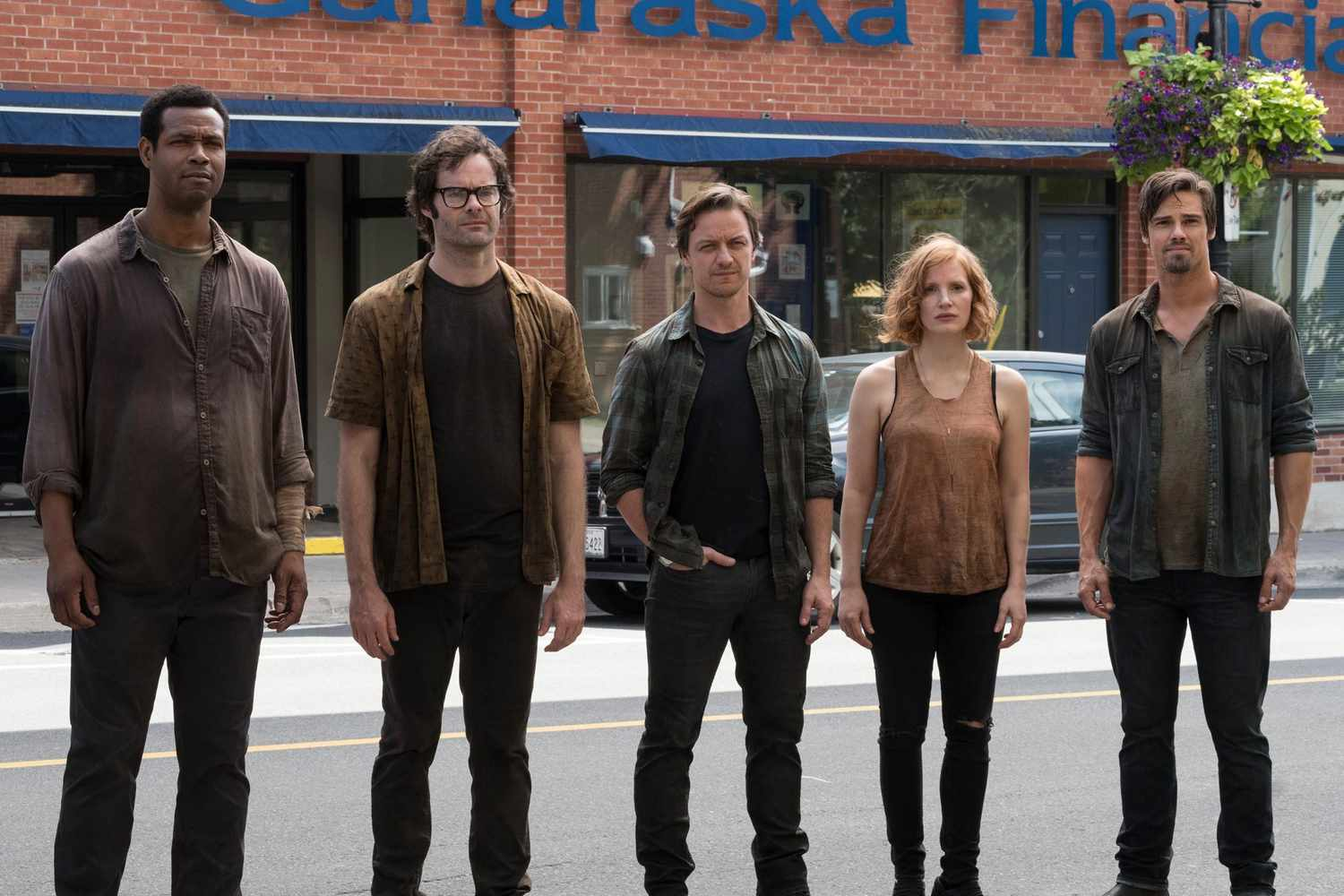‘It: Chapter 2’ and Its Messy, Mythic Legacy

There are no guarantees in filmmaking. While Stephen King’s It and the subsequent Tommy Lee Wallace miniseries pivoted between the Loser Clubs’past and present, Andy Muschietti’s It was announced as covering just the younger iterations’ trials and triumphs with cosmic horror Pennywise the Dancing Clown (played with classic precision by Bill Skarsgård). Had the movie not been successful, there remained a chance the much-hyped It: Chapter 2 teaser at the end of the first would have been for naught, another notch in a long line of canceled projects. For reference: World War Z is playing on cable in the background while I write this.
Prior to release, it might well have been. The development of a feature adaptation began back in 2009. Warner Bros. wanted to capitalize on the ever-popular Stephen King brand, and while It isn’t his scariest book (that’s Pet Sematary), it unequivocally yields the most considerable cultural cache. Pennywise the Dancing Clown is a horror icon, and Tim Curry’s phenomenal 1990 iteration remains one of the scariest movie villains of all time. It’s that good, a carnival of physicality and charm both alluring and frightening all the same.
At the film’s inception, David Kajganich (writer of several Luca Guadagnino features) was attached to direct. When he bowed out, Cary Fukunaga (True Detective) got on board. When he departed—though he remains credited for the film’s screenplay—Mama’s Andy Muschietti signed on. Muschietti referenced the likes of The Howling, Stand by Me, and The Thing as inspiration. It was filmed in 2016 and released in 2017. To call It a success would be an understatement.

It grossed over $700 million against a $35 million budget. At present, It (heretofore referred to as Chapter 1) holds the record for both the highest-grossing horror film ever and the highest-grossing Stephen King movie of all time. No small feat for a dancing clown and a Stranger Things-lite narrative pulse. And, to get it out of the way now, Chapter 1 isn’t quite the phenomenon now it was at release. With a little distance, Chapter 1 is retroactively safe, a hodgepodge of nostalgic crudeness and digital Conjuring Cinematic Universe baddies (Gary Dauberman, a credited writer on the script, also scripted Annabelle, its two sequels, and The Nun).
Chapter 1 was less a subversion of the contemporaneous 2017 horror scene, and more its apex. While there was nothing new, the craftsmanship and performances elevated Chapter 1 to the level of sensation. Of course, there had to be a sequel. Two years later, there was.
It: Chapter 2 has an unfortunate legacy. The modern reassessment of Chapter 1 is inextricably linked to Chapter 2’s reception. Early reactions, at least, were strong. Bill Hader’s performance as Richie Tozier was praised, the scale was appropriately (and welcomely) epic, and—for better or worse—some critics found it scarier than the first.
Still, there was a lot (a lot, lot) of hedging. The first reactions were abounding with caveats, language to warrant the mixed reaction. Good, not great. Fun, but overstuffed. Scary, but slight. Curiosity remained piqued, however. This was a horror movie with a budget nearing $100 million. That’s blockbuster levels. Keep in mind, the horror scene at the time (and, really, for time immemorial) had been predicated on low budgets, high returns. The Blumhouse model—one of the genre’s most influential production companies—operates according to that very ethos.
The first teaser trailer for It: Chapter 2 was, in fairness, laughable. First, it conceded to my least favorite modern marketing trend. Rather than teasing (which is in the name, after all), the trailer instead opts to simply show an entire scene. Here, it was Beverly Marsh’s (Jessica Chastain) visit to her childhood home. The scene’s climax is just… there. What follows is thirty seconds of Avengers-style team-ups. The Losers Club aren’t losers anymore—they’re superheroes.
The music doesn’t fit, and while there was a brief moment of, “Oh, yeah” with the casting, it was the first sign of the plague to come. I love fans and fan interactions, but fan casting has never been wise. Almost the entirety of the adult Losers Club is incredulously linked to fan theories from two years prior. Days after Chapter 1 was released, the internet was abuzz with wishes for Jessica Chastain to play the adult Beverly. Chastain is fantastic in the role, but her presence is a simultaneous constraint. It’s too meta, too conspicuous, to allow for the necessary suspension of disbelief that makes a scary movie, well, scary. Bill Hader as Richie Tozier was simultaneously predicted and confirmed.
The second trailer was better but still reeked of a sequel too big for its britches. The intimate terror of King’s writing could never withstand a swelling orchestra and the kinds of cosmic effects Tommy Lee Wallace could only dream of. Absent those, the 1990 miniseries wisely fell back on Curry’s performance. Conversely, Chapter 2 regularly sent Skarsgård to the back burner for a number of digitally augmented scares. Sure, it’s from the source material, but Stanley Kubrick changed The Shining’s Hedge Animals into a maze for a reason.
Which is to say nothing of the movie itself. So, was It: Chapter 2 actually good? No, not really, at least not at first. Then miraculously, on its fifth anniversary, the movie felt a lot better. The incredulously mythic scale, the bloated, nearly three-hour runtime. Brazenness isn’t enough for a movie to work, but there’s still innate value in a movie going all in, especially a horror movie. Yes, teasing terror is more disorienting and haunting, and Chapter 2 won’t instill any nightmares. But sometimes it’s nice for a horror movie to put the entire cosmic kitchen sink on-screen for the audience to relish in.
Chapter 2 does start in a rough space, and it’s one of the few parts of the movie that registers as worse, not better, with age. Adrian Mellon’s (filmmaker Xavier Dolan) death is too cruel for Chapter 2’s fluff. Yes, again it’s culled from the source material, but a little restraint is needed. That the noncommittal queer undercurrent extends throughout the entirety of Chapter 2, principally as it pertains to Richie and Eddie Kasprak (James Ransone), doesn’t help. Pennywise only appears every 27 years, and so too, it seems, does a mainstream horror blockbuster with the sensitivity to earnestly include queer elements. By 2046 we’ll be set.
The subsequent first act—the real first act of the movie—is better, if indicative of Chapter 2’s worst impulses. One by one, trauma-lite takes root, with the previous film’s Losers, now adults, slowly succumbing to the urge to return to Derry, Maine to finish what they started years before. Beverly Marsh is trapped in an abusive relationship. Bill Denbrough (James McAvoy) can’t… write a good ending? Richie is a closeted, though successful, comedian. Mike (Isaiah Mustafa, one of the film’s saving graces), stayed in Derry. Ben Hanscom (Jay Ryan) is a successful architect whose longstanding crush on Beverly torments him. Eddie, poor Eddie, is basically married to his abusive mother, and Stanley (Andy Bean), dies by suicide, too afraid to return.
The infamous meet-up at a Derry Chinese restaurant, Jade of the Orient, remarkably captures the best, and worst, of the studio’s instincts. Upping the ante on King’s written culinary horror, the fortune cookie monsters and subsequent icks and gags are bolstered by newer technology and Muschietti’s vision. Now, there can be floating heads, insect creatures, and oozing bowls of blood.

There’s a caveat, however—it’s all fake. Digital tomfoolery aside, Chapter 2 might be remembered more fondly. But, as the Jade of the Orient scene indicates, it’s just too hard to ignore the obviously digital monstrosities menacing our heroes. It extends beyond even being a matter of taste—I think plenty of horror CG is done well—because it spotlights Muschietti’s still burgeoning talents as a tactile director.
Blocking, lighting, and even a general sense of rhythm from one cut to the next all lack physicality. There is no proximal menace, no sense that anyone is in any real danger. And, sure, in both the miniseries and the novel, the scene is a nudge, not a full-borne nightmare where our characters are in any genuine danger, but the original miniseries was plenty gag-inducing, adroitly demonstrating the lengths Pennywise himself was going to in order to keep the older Losers out of his way. Chapter 2’s was all digital glitz, no glamour.
The bonafide second act thus begins, and that’s where Chapter 2 really has some problems. The Losers split up for haunted houses of their own, a filmic version of a Halloween Haunt at your local amusement park. The characters separate, get scared, and return. It’s not a bad idea, especially with an ensemble this large, and wisely, Muschietti does stick to some of the novel’s original ideas. The thrust is each Loser needs some memento of their childhood to render the Ritual of Chüd effective. For everyone’s sake, I’m going to leave the ritual alone.
As shown in the trailers, Beverly has a frightening encounter at her childhood home. It’s fine. Not nearly as simple yet terrifying as the original, but it is serviceable enough (even if Pennywise’s monstrous shape takes the form of every slender, pallid humanoid seen that century, from [REC] to Blair Witch). At school, Ben is menaced by a flaming Pennywise. Eddie has another encounter with Javier Botet’s returning Leper, and Richie is attacked by Pennywise by way of a possessed Paul Bunyan statue.
On their own, there’s a spark to these individual beats. Muschietti is nothing if not a visionary, and in their best moments, his adoration for King’s material is clear. Plus, there’s a capable cast at the core selling the terror. Watching an A-lister recoil in fear is one of the horror genre’s greatest pleasures. Where the moments are less effective, however, are in their scares. I’ve written before about the state of modern jump scares, namely the contemporary phenomenon whereby most jump scares conclude their given scenes. It’s a jolt as punctuation. The sheer volume is disruptive to pacing. While scares might adhere to the old formula, the stages by which a scene builds and then releases, the stop/start nature of cutting from one scare to set up the next can be exhausting.

The pacing is detrimental to scares, detrimental to character, and detrimental to an overarching sense of narrative awareness, the notion that we know where we are, what’s happening there, and to whom it is happening. Instead, it’s just a lot of loud noises. Pennywise’s use should be strategic, but those individual beats reduce him to a glorified cameo. He pops out, screams ‘Boo,’ and leaves. After 27 years, that’s all you have.
To shift away from the negativity—I’m nothing if not fair—Chapter 2 finds its stride in the finale. The Losers descend into the house on Neibolt Street and confront Pennywise. Yes, the finale is punctuated by more digital nonsense, including Pennywise in the form of a giant spider, and it’s never sufficiently clear why, at this stage, Pennywise still has nothing better in his arsenal than some spooky hallucinations to distract the disparate Losers. They all band together, however, and bully the shit out of Pennywise. Literally. And it’s sensational. Not even in a “so bad, it’s good” way. It’s just good. All their pent-up frustration and rage. They’re not scared anymore. After 27 years, they’re just tired, and they’re damn certain to make sure Pennywise knows that.
He shrivels, Mike steals his heart, and they all crush it. Pursuant to the source material, Eddie dies along the way, though Chapter 2 doesn’t have any time to really deal with that (and, luckily, avoids the miniseries bike ride out of catatonia). The ending is cute fluff, minus a misguided suggestion that Stanley’s death by suicide was a gift to his friends.
All that, plus so much more, over the course of almost three hours. Mythic. Massive. Perhaps the biggest horror movie of our time aside from the Alien franchise. This was horror as an event, horror as a tentpole. And, respectably, horror managed a solid $473 million gross. Nowhere near the original, but worth diving back into the sewers for.
Categorized:Editorials News
